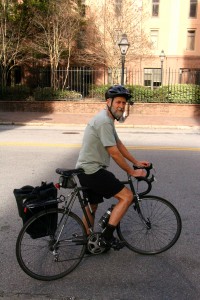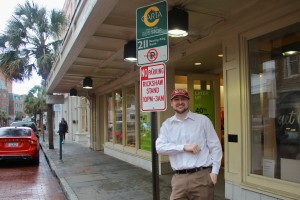#CofCMoves: Alexa Thacker Moves by CARTA
How do you move? Do you walk, bike, or use public transit? Join the Office of Sustainability and participate in the College’s first official event celebrating the different modes of transportation that the College community uses to commute to campus. On April 9th, during Sustainability Week, let us know how you move by using #CofCMoves and why you move the way you do!
We asked Alexa Thacker of the Office of Institution Events why she rides CARTA.
Office of Sustainability: What is your role at the College and how long have you worked here?
Alexa Thacker: I serve as Facilities and Events Support in the Office of Institutional Events and have been at the College for 11 years.
OOS: Why do you bus, bike, walk, and/or carpool rather than driving?
AT: I take CARTA for a variety of reasons, but mainly because it’s convenient and a perk of working at the College, and I don’t have to worry about traffic and downtown parking and expensive garages. I can get work done or read a book and relax on the bus ride instead of having to focus on the road and the nutty drivers around me. It also reduces wear and tear on my car, saves on gas, and helps me feel better about my footprint since I’m not just one more person driving to work alone.
OOS: How long have you been doing so?
AT: Approximately 6 years
OOS: How far do you commute daily?
AT: 20 miles round trip
OOS: What are the benefits to commuting by bus versus driving alone?
AT: Besides the reasons I mentioned above, I get to catch up with folks that I might not normally get to chat with while we’re waiting for the bus. It’s also sometimes an extreme exercise in patience, especially when the bus is running late and you have obligations that are being impacted. But I figure I’ve usually been placed in the situation for a reason, and I just need to look for the positives in it.
OOS: What do you value most about the way you commute?
AT: Being able to catch a few extra winks of sleep while on the bus.
OOS: What is the biggest challenge you face as a commuter?
AT: Late buses! Particularly when the weather is not perfect and you’re standing out at the stop and can’t get information from the CARTA dispatcher about when the bus may be arriving.
OOS: What are some improvements you’d like to see?
AT: A major improvement that has already helped is the online Bus Tracker. When I first started riding, CARTA had some sort of notification system that was completely useless; I think it actually only existed in name only. The Bus Tracker gives a much more accurate time frame of arrival and departure times at a certain stop, yet I do think they could add in text notifications or warnings that indicate when a bus is in an accident or has broken down along with an ETA of next service so that we can make alternative arrangements as necessary.
OOS: Would you recommend this method to others?
AT: I do. Most people are surprised when I say I take a bus to and from work. I think it’s great. I, however, can only speak to using the Express Bus and the DASH Trolley system.
OOS: Do you have any fun commuting stories?
AT: One time I was just zoned on my way home in the afternoon; I have no idea what I was thinking about. But I climbed aboard the bus, recognizing the driver. I didn’t pay too much attention to the folks riding, though a few looked new. We get to the interchange on Meeting and instead of taking a right to Mt. P, the driver goes left. I’m thinking, “what the heck?!” It’s then that I realize I had gotten on the wrong bus and was on my way to North Charleston; the driver was covering a different shift and I didn’t look to see which bus was which. So I ended up riding all the way to the North Charleston K-Mart and back downtown to the Charleston Museum and got on the next bus to Mt. P. I did get quite a bit of paperwork done that afternoon during that detour!





